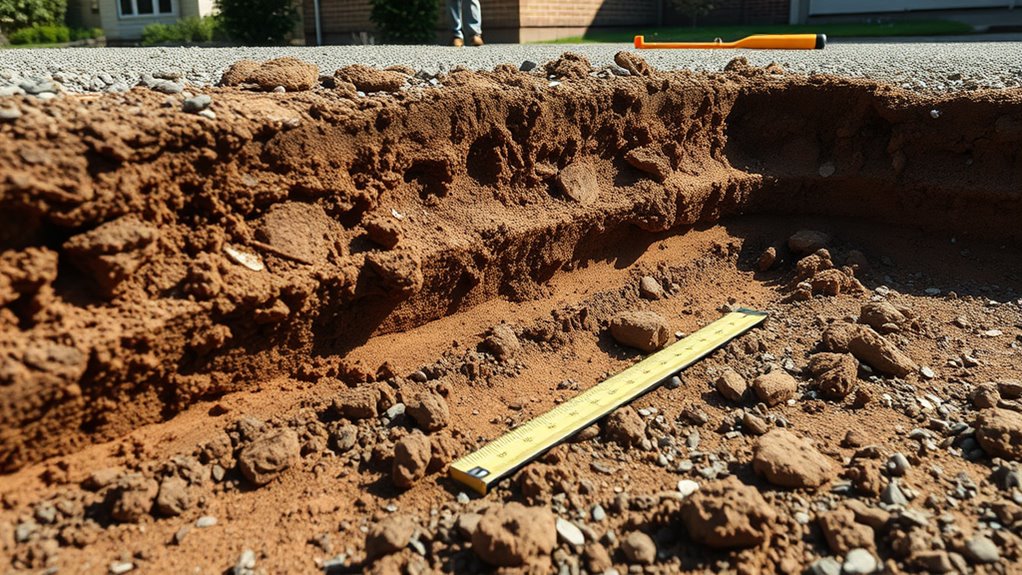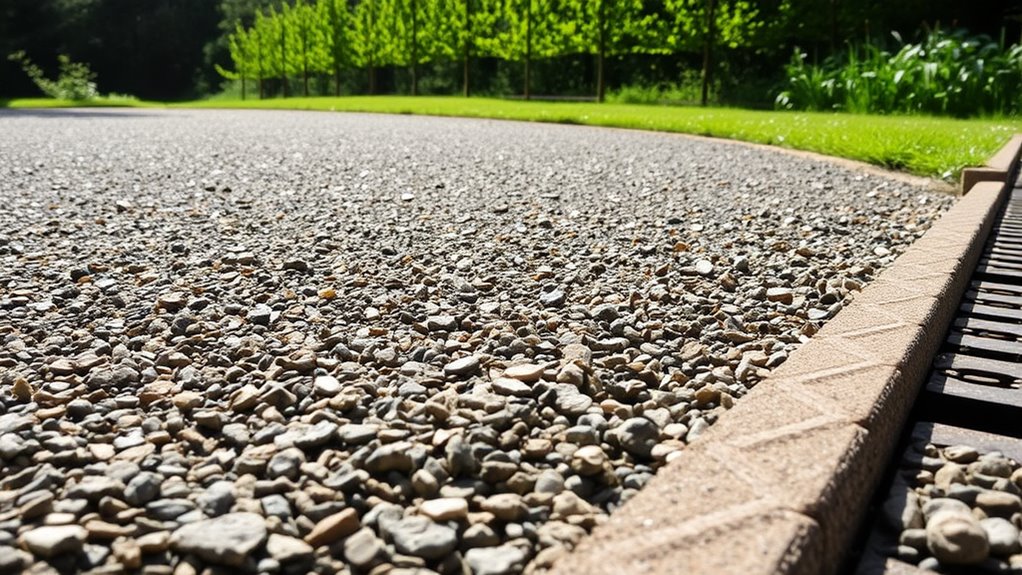Simply dig out existing surfaces to 150mm depth as your starting point for a resin bound driveway. Type 1 MOT stone works brilliantly as your sub-base material – it's what most UK contractors swear by. Spread the stone in even layers, making sure to compact each one properly with a whacker plate. You'll want the surface dead level, so check it with a spirit level and clear off any bits and pieces.
For proper drainage (and to meet UK SUDS requirements), stick to permeable materials throughout. This helps avoid puddles forming on your drive when we get our typical British weather. Getting the sub-base right is crucial – skimp on this stage and you risk the whole driveway sinking or cracking down the line. Rather like building a house, it's all about getting the foundations spot-on.
Key Takeaways
Sub-Base Preparation for Resin Bound Driveways
- Dig out the existing ground 100mm to 250mm deep, depending on your soil type and intended usage (deeper for driveways that'll bear vehicles).
- Remove all loose material, weeds and rubbish – a spotless base is crucial for proper installation.
- Add Type 1 MOT stone in layers, roughly 50mm at a time. Compact each layer thoroughly with a vibrating plate – you should hear a change in tone when it's properly compacted.
- Use permeable materials that meet UK SUDS requirements – this prevents flooding and ensures proper water drainage through the sub-base.
- Check the finished surface with a straight edge. It should be level, stable and free from dips or bumps before you start laying the resin bound surface.
Suitable Sub-Base Materials
Sub-Base Options for Resin Bound Driveways
Tarmac and concrete serve as the main sub-base options for resin bound driveways, each offering distinct advantages.
Tarmac provides excellent permeability, meeting SUDS regulations for water drainage. Whilst 50mm depth is adequate, 100mm offers better stability. It works particularly well in British weather conditions, though proper edge restraints are crucial to prevent shifting. Tarmac must be laid on an MOT type 3 sub-base to ensure adequate support.
Concrete delivers superior strength for high-traffic areas. It requires a minimum 100mm depth and C35 strength grade. To prevent cracking, steel mesh reinforcement and repair mortar are essential at open bay joints.
Your choice between tarmac or concrete should reflect local conditions and usage requirements. The right sub-base is vital for ensuring your resin bound driveway remains durable and functional throughout British weather conditions.
Steps for Sub-Base Preparation

First, carefully remove existing surfaces like grass, soil or old paving through excavation.
Dig to a suitable depth – typically 100mm to 250mm – using proper equipment such as mini-diggers.
Clear away all debris to create a clean working area.
Next, lay your sub-base material in even layers.
Grade each layer properly and compact it thoroughly using a plate compactor or roller.
Keep an eye on moisture levels whilst compacting, as this affects the final result.
Check each layer after compaction for evenness and stability.
Test the density to ensure it meets UK standards.
Before moving on to the resin bound surface, give the sub-base a final inspection.
Look for any damage or loose material that needs addressing.
A properly prepared sub-base is crucial for a long-lasting driveway, as it provides the necessary support for the durable surface that the resin-bound system will create.
Take time to get this foundation right, and you'll avoid problems later.
Sub-Base Depth Requirements

Getting the right sub-base depth is crucial for a lasting resin bound driveway. For footpaths and patios, you'll need at least 100mm, whilst driveways need a minimum of 150mm. Use a properly compacted Type 1 MOT stone sub-base, typically laid between 150mm to 225mm deep. A well-prepared sub-base ensures the longevity of the surface and prevents issues related to poor installation. Additionally, proper edge restraints must be installed to contain the resin and prevent spreading.
The correct depth prevents common problems like sinking and cracking – much like building a house needs solid foundations. For tarmac surfaces, you'll want at least 50mm depth, or 60-70mm if using open-grade tarmac. If you're installing permeable grids, these need about 40mm depth, with 120-150mm of base material underneath.
When digging out your driveway, plan for a sub-base depth between 100mm to 250mm, based on what you're using it for. Think of a family car versus heavy vehicles – they need different levels of support. Always ensure thorough compaction, and get professionals to install the resin layer for best results.
Ensuring SUDS Compliance

Ensuring your resin bound driveway meets SUDS compliance is vital for both legal requirements and practical performance. The key lies in creating a proper permeable base using Type 1 MOT aggregate or open-textured binder course tarmac. Your base must effectively handle water drainage into the ground below.
For full compliance, you'll need a specialist mix of porous concrete or open-grade material laid over Type 3 MOT aggregate.
SUDS compliance offers real benefits: it reduces local flood risks and supports natural water management. A properly built base ensures your driveway drains effectively, preventing damage whilst helping natural groundwater levels. Additionally, a well-constructed permeable paving system can store significant amounts of water, aiding in groundwater replenishment.
Worth noting: SUDS compliance means you won't need planning permission for larger driveways, as they'll already manage rainwater at the source.
For materials, recycled aggregates work brilliantly – they're both cost-effective and fully compliant. A SUDS-compliant driveway needs less maintenance and helps manage urban water flow, making it a smart choice for UK properties.
Focus on these core requirements to ensure your resin bound driveway works properly and meets all environmental standards.
Common Installation Mistakes

Common Installation Mistakes for Resin Driveways
Getting your SUDS paperwork sorted is only half the battle – proper installation makes all the difference between a lasting resin driveway and a costly headache.
These crucial mistakes can wreck your driveway's stability and durability:
Shoddy Ground Prep
Skip proper excavation and compaction, and you're asking for trouble. Your base must be rock-solid.
Cheap Materials
Cutting corners on resin or aggregate quality is a false economy. Budget materials mean early repairs.
Wrong Depth
Lay it thinner than 15mm, and you'll likely face cracks and lifting. Proper depth is non-negotiable.
Missing Expansion Joints
Without these, your driveway can't handle temperature changes properly. Cracks will follow.
Poor Timing
Hot weather speeds up resin curing. What works on a mild day won't do in summer heat – timing matters. Additionally, ensuring a suitable permeable sub-base can enhance water drainage and prolong the lifespan of your driveway.
Frequently Asked Questions
Can I Install Resin Bound Driveways in Cold Weather?
Installing resin bound driveways during cold weather is possible but requires careful planning. Whilst British winters present unique challenges, successful installation depends on maintaining proper temperature controls and using frost-resistant materials. The resin mixture needs temperatures above 5°C to cure properly – think of it like setting concrete. Essential steps include ensuring thorough drainage to prevent ice damage, using high-quality UV-stable resins that withstand our cold climate, and watching the weather forecast to avoid installation during freezing spells. Professional installers typically recommend autumn or spring fitting for optimal results.
How Long Does a Resin Bound Driveway Last?
A well-installed resin bound driveway typically lasts 15-25 years. The longevity depends heavily on proper installation, quality materials and regular maintenance. Top-quality UV-stable resins and correct aggregate mixtures prevent common issues like colour fading and cracking. Much like caring for a garden path, simple upkeep such as regular sweeping and occasional pressure washing helps maintain its appearance and structural integrity.
Can I Use Resin Bound Driveways for Commercial Properties?
Resin bound driveways work brilliantly for commercial properties across the UK. They're tough enough to handle heavy foot traffic and vehicles, whilst looking smart and professional – perfect for office car parks, retail spaces and business parks. Just ensure you've got a solid sub-base, proper drainage and get a qualified installer on board to do the job properly. Think of it like laying the foundations for a house – get the basics right, and you'll have a durable surface that lasts for years.
What Colors Are Available for Resin Bound Driveways?
Resin bound driveways come in a wide range of colours to suit any property style. Common choices include natural stone shades like Cotswold buff and Yorkshire grey, warm earth tones such as terracotta and autumn gold, and contemporary neutrals like silver granite and slate grey. These colours work brilliantly with both modern and traditional British homes, whilst offering practical kerb appeal.
How Do I Maintain My Resin Bound Driveway?
Regular cleaning with a stiff brush and pressure washer keeps your resin bound driveway in top condition. Sweep away leaves and dirt weekly, and give it a thorough wash every few months. A fresh coat of specialist sealant every 2-3 years, much like waxing your car, protects against Britain's wet weather and prevents moss growth. Think of it as essential maintenance, similar to servicing your boiler – a bit of care now saves hassle later.
Conclusion
Proper sub-base preparation isn't just about laying foundations – it's essential for a lasting resin driveway. Getting the materials right and following correct depth measurements will prevent costly repairs down the line. Steer clear of common mistakes, and your driveway will deliver both kerb appeal and reliable performance for years ahead.
